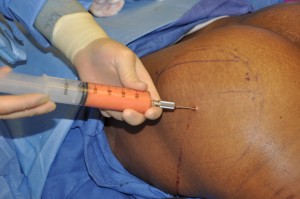Buttock augmentation continues to grow in popularity, largely driven by the acronym BBL. The Brazilian Butt Lift is a moniker for the transfer of autologous fat into the buttocks though injection using the patient’s own fat harvested by liposuction. Besides being a natural procedure, the additional benefit of body contouring from the liposuction part of the procedure complements the changes to the buttocks as well.

In the August 2014 Online First edition of the Aesthetic Surgery Journal, an article entitled ‘Abdominoplasty-Derived Dermal-Fat Graft Augmentation Gluteoplasty’. In this paper, nine (9) patients that had lower abdominal dermal-fat grafts used for buttock augmentation were reviewed. These were patients that were undergoing abdominoplasties (tummy tucks) in which two oval-shaped dermal-fat grafts were harvested from their tummy tuck excisions and transferred to their buttocks in a subfascial location. The mean size of the dermal-fat grafts was just under 200 cm2 with a mean weight of 288 grams. One of the eighteen grafts became infected (5.5%) and had to be removed six weeks after surgery. All other grafts survived and provided a lasting increase in buttock volume and projection.
This study shows that large dermal-fat grafts in the buttocks are safe and do not have a high risk of infection or complete fat necrosis. The history of dermal-fat grafts goes back almost 100 hundred years but most of that experience has been in smaller graft sizes that do not approximate that used for the buttocks. It would be interesting to see long-term results (one year) of how much volume was obtained as even large dermal-fat grafts undergo some volume loss based on my experience.
I can not help but speculate that a large dermal-fat graft may be better suited to be placed in an intramuscular position as opposed to a subfascial one. Similar to the placement of an intramuscular implant, the improved vascularity may aid in its survival and volume retention.
For those tummy tuck patients who are also interested in buttock augmentation (or vice versa), the excised tummy tuck segment can be successfully used to create small to moderate amounts of buttock augmentation. If it is placed in an intramuscular location, fat injections could also be done in the subcutaneous location as well for improved amounts of volume increase.
Dr. Barry Eppley
Indianapolis, Indiana


